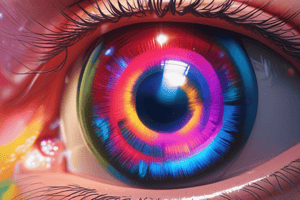Podcast
Questions and Answers
What phenomenon occurs when staring at an image and then looking at a white surface?
What phenomenon occurs when staring at an image and then looking at a white surface?
- Color perception
- Visual acuity
- Color blindness
- Afterimage (correct)
Which cells are primarily responsible for color vision in bright light?
Which cells are primarily responsible for color vision in bright light?
- Rod cells
- Red cone cells
- Blue cone cells
- Cone cells (correct)
What happens to the red cone cells when a person stares at a red image for an extended period?
What happens to the red cone cells when a person stares at a red image for an extended period?
- They increase sensitivity to light
- They become stimulated
- They become fatigued (correct)
- They enhance brightness perception
What type of vision do rod cells provide?
What type of vision do rod cells provide?
Which cone cells are activated when viewing a white surface after staring at a red image?
Which cone cells are activated when viewing a white surface after staring at a red image?
What happens to the pupil in dim light?
What happens to the pupil in dim light?
Which muscles of the iris contract to dilate the pupil?
Which muscles of the iris contract to dilate the pupil?
Why is it important to control the amount of light entering the eye?
Why is it important to control the amount of light entering the eye?
What occurs when the circular muscles of the iris relax?
What occurs when the circular muscles of the iris relax?
What is the function of the iris in relation to the pupil?
What is the function of the iris in relation to the pupil?
In bright light, what happens to the radial muscles of the iris?
In bright light, what happens to the radial muscles of the iris?
How do the circular and radial muscles work together?
How do the circular and radial muscles work together?
What might happen if there is too much light entering the eye?
What might happen if there is too much light entering the eye?
What is the primary function of eye accommodation?
What is the primary function of eye accommodation?
What happens to the ciliary muscles when focusing on a near object?
What happens to the ciliary muscles when focusing on a near object?
What change occurs in the lens when focusing on a distant object?
What change occurs in the lens when focusing on a distant object?
Which combination correctly shows the conditions of the lens and suspensory ligaments when focusing on a near object?
Which combination correctly shows the conditions of the lens and suspensory ligaments when focusing on a near object?
What effect does the contraction of circular ciliary muscles have on the lens?
What effect does the contraction of circular ciliary muscles have on the lens?
Which statement is true regarding short sight?
Which statement is true regarding short sight?
What happens to the tension in the suspensory ligaments when focusing on a near object?
What happens to the tension in the suspensory ligaments when focusing on a near object?
When focusing on distant objects, what happens to the light refraction by the lens?
When focusing on distant objects, what happens to the light refraction by the lens?
What happens to light rays from near objects before entering the eyes?
What happens to light rays from near objects before entering the eyes?
Where do light rays from a near object focus if not corrected?
Where do light rays from a near object focus if not corrected?
What type of lens is used to correct long sight?
What type of lens is used to correct long sight?
What should light rays from a distant object look like in a ray diagram?
What should light rays from a distant object look like in a ray diagram?
How should the direction of light rays be indicated in a ray diagram?
How should the direction of light rays be indicated in a ray diagram?
What type of light rays should be drawn for near objects in a ray diagram?
What type of light rays should be drawn for near objects in a ray diagram?
What happens to light rays when they enter the cornea and lens?
What happens to light rays when they enter the cornea and lens?
What is the result of light rays not focusing correctly on the retina?
What is the result of light rays not focusing correctly on the retina?
What is the primary function of the cochlea?
What is the primary function of the cochlea?
Which canal in the inner ear senses head tilting towards the right or left shoulder?
Which canal in the inner ear senses head tilting towards the right or left shoulder?
What converts sound waves to mechanical vibrations?
What converts sound waves to mechanical vibrations?
Which component of the ear amplifies vibrations before they reach the oval window?
Which component of the ear amplifies vibrations before they reach the oval window?
What is the role of sensory hair cells in the cochlea?
What is the role of sensory hair cells in the cochlea?
Which part of the inner ear is primarily associated with balance?
Which part of the inner ear is primarily associated with balance?
What signals the brain regarding the position of the head?
What signals the brain regarding the position of the head?
What is the function of the pinna in the outer ear?
What is the function of the pinna in the outer ear?
What is a common aid for individuals with red-green colour blindness?
What is a common aid for individuals with red-green colour blindness?
What causes astigmatism in the eye?
What causes astigmatism in the eye?
Which treatment is commonly used for cataracts?
Which treatment is commonly used for cataracts?
What is a symptom of glaucoma?
What is a symptom of glaucoma?
What is macular degeneration primarily known for affecting?
What is macular degeneration primarily known for affecting?
How can mobile phone applications assist those with color blindness?
How can mobile phone applications assist those with color blindness?
Which condition can result in blurred vision due to an error in refraction?
Which condition can result in blurred vision due to an error in refraction?
What is the primary cause of cataracts?
What is the primary cause of cataracts?
Flashcards
Afterimage
Afterimage
The effect of seeing a color after staring at its complementary color for a while.
Rod cells
Rod cells
Photoreceptor cells in the retina that respond to light and help us see in dim light conditions.
Cone cells
Cone cells
Photoreceptor cells in the retina that respond to light and help us see color in bright light.
Retina
Retina
Signup and view all the flashcards
Stimulus
Stimulus
Signup and view all the flashcards
What is the Pupil?
What is the Pupil?
Signup and view all the flashcards
What is the Iris?
What is the Iris?
Signup and view all the flashcards
What are circular muscles of the iris?
What are circular muscles of the iris?
Signup and view all the flashcards
What are radial muscles of the iris?
What are radial muscles of the iris?
Signup and view all the flashcards
What is Pupil Constriction?
What is Pupil Constriction?
Signup and view all the flashcards
What is Pupil Dilation?
What is Pupil Dilation?
Signup and view all the flashcards
What are Rods?
What are Rods?
Signup and view all the flashcards
What are Cones?
What are Cones?
Signup and view all the flashcards
Eye Accommodation
Eye Accommodation
Signup and view all the flashcards
Ciliary Muscles
Ciliary Muscles
Signup and view all the flashcards
Suspensory Ligaments
Suspensory Ligaments
Signup and view all the flashcards
Lens Curvature
Lens Curvature
Signup and view all the flashcards
Focusing on a distant object
Focusing on a distant object
Signup and view all the flashcards
Focusing on a nearby object
Focusing on a nearby object
Signup and view all the flashcards
Short Sight
Short Sight
Signup and view all the flashcards
Long Sight
Long Sight
Signup and view all the flashcards
Focusing on distant objects
Focusing on distant objects
Signup and view all the flashcards
Focusing on near objects
Focusing on near objects
Signup and view all the flashcards
Correction of long sight
Correction of long sight
Signup and view all the flashcards
Ray diagrams: light direction
Ray diagrams: light direction
Signup and view all the flashcards
Ray diagrams: distant objects
Ray diagrams: distant objects
Signup and view all the flashcards
Ray diagrams: near objects
Ray diagrams: near objects
Signup and view all the flashcards
Ray diagrams: arrowheads
Ray diagrams: arrowheads
Signup and view all the flashcards
What is red-green color blindness?
What is red-green color blindness?
Signup and view all the flashcards
What is astigmatism?
What is astigmatism?
Signup and view all the flashcards
What is a cataract?
What is a cataract?
Signup and view all the flashcards
What is glaucoma?
What is glaucoma?
Signup and view all the flashcards
What is macular degeneration?
What is macular degeneration?
Signup and view all the flashcards
What are aids for color-blind people?
What are aids for color-blind people?
Signup and view all the flashcards
What are test cards for color blindness?
What are test cards for color blindness?
Signup and view all the flashcards
What is a refraction error?
What is a refraction error?
Signup and view all the flashcards
Sound wave to vibration
Sound wave to vibration
Signup and view all the flashcards
Middle ear amplification
Middle ear amplification
Signup and view all the flashcards
Vibrations to waves
Vibrations to waves
Signup and view all the flashcards
Hair cell stimulation
Hair cell stimulation
Signup and view all the flashcards
Brain interpretation
Brain interpretation
Signup and view all the flashcards
Semicircular canals
Semicircular canals
Signup and view all the flashcards
Anterior canal function
Anterior canal function
Signup and view all the flashcards
Posterior canal function
Posterior canal function
Signup and view all the flashcards
Study Notes
Stimuli, Receptors, and Responses
- Organisms can detect and respond to stimuli (changes in their environment)
- Irritability is an organism's ability to detect stimuli and respond appropriately
- Stimuli can be internal or external and are detected by sensory cells called receptors
- Receptors often group together to form sense organs. Examples of sense organs in humans are the eyes and ears.
Human Eyes
- Eyes are the sense organs for detecting light
- About 80% of environmental information comes from sight
- Structures surrounding the eye: eyebrows, eyelashes, eyelids, tear glands
- Eyebrows prevent sweat from entering the eye
- Eyelashes trap dirt
- Eyelids protect the eye from foreign objects and bright light
- Tear glands produce tears to keep the eye moist and clean, containing an enzyme that kills bacteria.
Internal Structures of the Eye
- Eyeball is composed of 3 layers: sclera, choroid, retina
- Sclera: tough outer layer, gives shape and protects, eye muscles attach to it
- Cornea: transparent, front of the eye, light enters through it, refracts light
- Choroid: blood vessels and a dark pigment; absorbs light to prevent reflection
- Retina: contains rods and cone cells to detect light
- Rods: stimulated by low light levels, black and white vision
- Cones: stimulated by high light levels, colour vision; concentrated in the fovea (yellow spot)
- Light is passed through the cornea, aqueous humor, lens, and vitreous humor, eventually focusing onto the retina to create an image. The brain interprets these signals to produce vision
Eye Accommodation
- The lens changes shape to focus on objects at different distances
- Focusing on a near object: ciliary muscles contract, suspensory ligaments loosen; lens becomes thicker (more convex)
- Focusing on a distant object: ciliary muscles relax, suspensory ligaments tighten; lens becomes thinner (less convex)
Eye Defects and Correction
-
Short-sight (Myopia): Eyeball too long or lens too thick, distant objects blurry
-
Correction: Concave (diverging) lens to spread out light rays before they enter the eye
-
Long-sight (Hyperopia): Eyeball too short or lens too thin, near objects blurry
-
Correction: Convex (converging) lens to converge light rays before they enter the eye
Human Ears
- Ears detect sound
- Three parts: outer ear, middle ear, inner ear
- Outer ear: pinna (collects sound waves), auditory canal (directs waves to eardrum)
- Middle ear: eardrum (vibrates), ear bones (amplify vibration; transmit to oval window)
- Inner ear: oval window (transmits vibrations to cochlea), round window(releases pressure), semicircular canals (detect head movement), cochlea (filled with liquid; vibrations stimulate sensory hair cells; generates signals that travel to the brain through the auditory nerve)
Phototropic Responses in Plants
- Phototropism: directional growth in response to unilateral light (light coming from one direction)
- Shoots grow toward light (positive phototropism). Roots grow away from light (negative phototropism).
- Auxins are plant hormones that control growth in shoots and roots and are involved in phototropism. Auxins move to the shaded side, resulting in unequal growth and the bending of the plant part toward the light source.
- Auxin concentration affects both shoot and root growth differently. High concentrations promote shoot growth but inhibit root growth
Studying That Suits You
Use AI to generate personalized quizzes and flashcards to suit your learning preferences.




